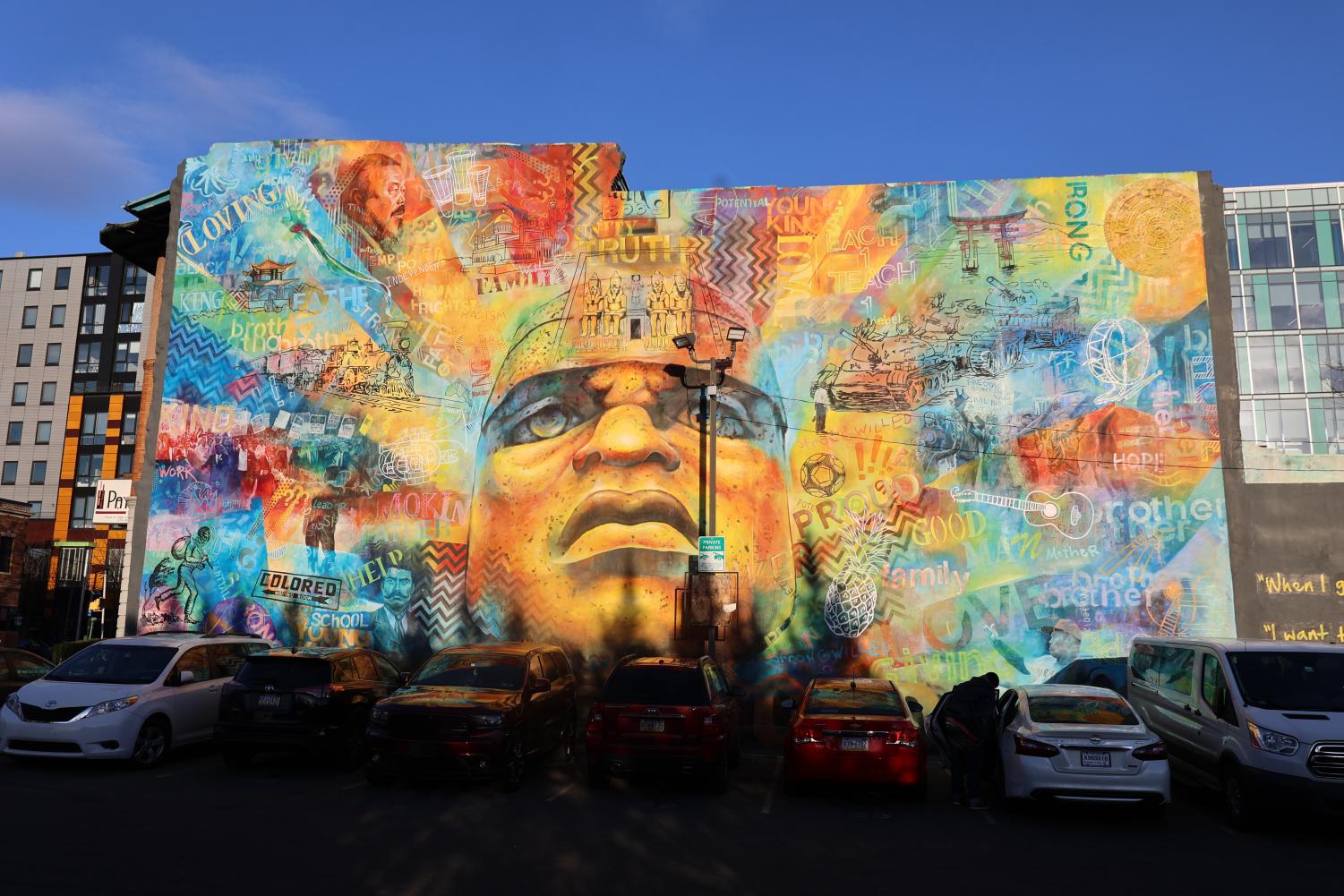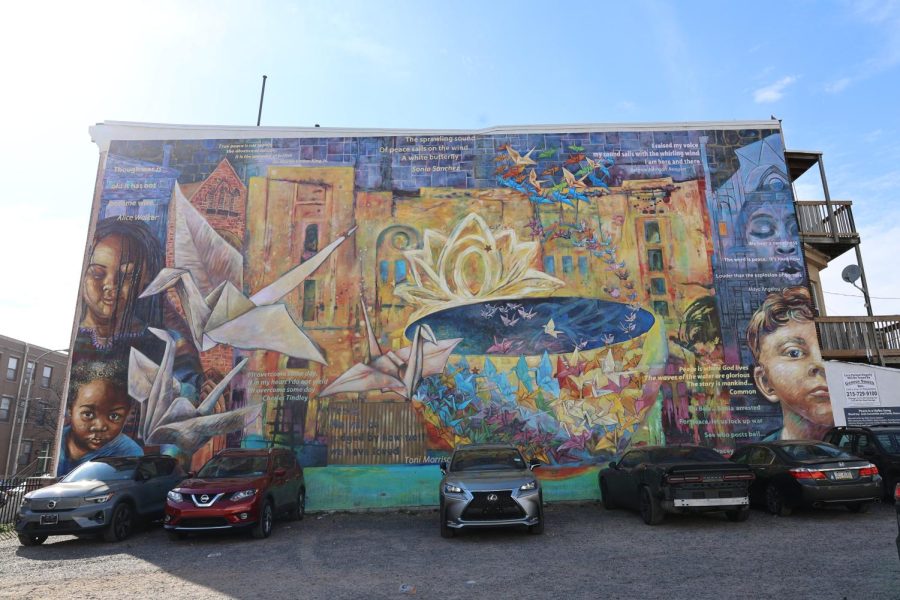Painting Stories
May 1, 2023
As people walk through the streets of Philadelphia, turning one corner to the next, some might keep their heads down. But when one turns to look up, they find a unifying art form that has transcended individuality and painted Philadelphia magical. Welcome to the mural capital of the world.
Philadelphia’s historical past has shaped the city’s murals while, similarly, the murals themselves have shaped Philadelphia’s history. In the latter half of the 20th century, cities like Philadelphia were grasping for a new form of public art as other art forms like monuments began gaining the reputation of being out of step with changing urban landscapes. Murals served as a contemporary mode of art that was both collaborative and inclusive: they offered diverse groups a chance to share their stories through an accessible means of visual storytelling. Simultaneously, Philadelphia was growing as a center of social reform, exemplified through the civil rights and women’s rights movements that took root in the city. In the 1960s and 1970s especially, with these movements’ focus on a united front against injustice, murals turned into an ideal tool for expressing their beliefs.
Furthermore, most pronounced in the 1960s, there was a growing flight to the suburbs based on societal changes like the Baby Boom. This, however, culminated in a lack of focus in cities like Philadelphia. In response, many artists turned to murals as an avenue to try to encourage further urban development and investment. Then, in the 1980s and 1990s, Philadelphia city life grew more attractive again for suburban residents as they became empty nesters and were drawn again to the benefits of the city. This fueled a process known as gentrification, or the process of wealthier people moving into urban areas, aiding in the development of the area but displacing pre-existing residents. Some argue that murals have been used as a tool in aiding in the development of low-income neighborhoods, sometimes leading to art that overlooks the rich and complex history of the neighborhoods. Moreover, some even argue that murals themselves promote gentrification, as beautifying low-income areas leads to the neighborhoods growing more attractive in the minds of affluent people looking to move.
Amidst the disagreements regarding the purpose of murals, they were also initially seen as a tool to deter other forms of street art. In the 1980s, the Philadelphia Anti-Graffiti Network (PAGN) promoted the creation of murals to try to ornament Philadelphia’s unique cityscape without turning to vandalism. In 1984, Mural Arts was founded as part of the PAGN initiative. Jane Golden, becoming the founding executive director of Mural Arts, revitalizing the efforts to use murals as a tool for transforming Philadelphia.
Now known as Mural Arts Philadelphia, the organization’s legacy and impact is carried through the more than 4,000 murals that are seen throughout the city covering topics from the 5 key program areas: Art Education, Community Murals, Restorative Justice, Porch Light, and Environmental Justice. Mural Arts Philadelphia uses the power of restorative justice to show the transformative nature of mural creation not only on an urban landscape but also on the artist themselves. The Restorative Justice Program aids individuals that were previously incarcerated by spearheading programs like art therapy in the creation of murals pertaining to topics within justice like mass incarceration. Meanwhile, for the art education program, the organization works with local youth in the city to empower the next generation of artists through after school programs for thousands of students. For community murals, Mural Arts Philadelphia works with local community members to develop murals that allow the reclamation of communal space. For porch light, the group collaborates with the City of Philadelphia’s Department of Behavioral Health and Intellectual disAbility services to try to provide assistance with Philadelphians in aiding in their wellness. With all of these different programs, Mural Arts Philadelphia has grown to be what it calls the largest public art program in the United States.
Mural Arts Philadelphia also works to demonstrate the power and beauty of Philadelphia’s murals to the community. For people interested in exploring the rich history of the murals in Philadelphia and walking through some of the city’s most prominent masterpieces, Mural Arts Philadelphia arranges the Center City Walking Tour under the direction of professional guides.
As Mural Arts Philadelphia developed, there were various ways that the style of art changed as well. At first, many murals were done using an array of paint mediums. This has eventually shifted to acrylic paint being the primary medium that is utilized due to its conveniences, including the ability to repaint and seal the murals whenever necessary. There were also differing methods with how the painting process was conducted. One way was by using cloth and then putting them on aluminum panels that could then be installed. Another method was also by painting murals on parachute cloth and then moved onto buildings which was introduced by the mural “Dr.J” by a muralist named Kent Twitchell in 1990.
Apart from the methodologies that have transformed, the process of bringing a mural to life and the changes that occur in a mural over time have led to new initiatives like mural restoration. Obtaining the necessary permissions to add a mural to a city wall, designing a mural, enduring the often-grueling process of bringing the design to life, and fighting off destructive forces like weather and vandalism are always challenging.
If works like frescoes and murals are not properly maintained, they will age and decay over time like wood and plaster can. Paint and finishes are susceptible to cracking, peeling, and chipping; canvas is vulnerable to tearing and delaminating; pigments are susceptible to oxidation and darkening; smoke, soot, and other debris can build up over decades or centuries; and water and mold can compromise the stability of the underlying structure that supports the painted work.
The mural restoration process begins when artists survey the building and figure out the original artist’s technique. The real work follows a fundamental pattern after analyzing each individual project primarily in the context of itself and its aim. Each step starts with a visual inspection, followed by written and visual documentation of the materials and existing circumstances. The optimal answer can be found using materials analysis and microscopic investigation. A treatment plan is created to clean the artwork and stabilize anything that is original. Stabilization may entail injecting a substance beneath the artwork to keep it stable such as epoxy. To protect the original artwork and keep it apart from any “infill” painting applied later in areas of paint loss, a conservation varnish is then painted over it.
One of the notable aspects of conservation work is that it is entirely reversible. However, mural restorers must adequately comprehend the work’s artistic nature to engage in greater artistic creativity.
While murals undergo the natural decay that comes with time, man-made destruction also has played a role in the gradual fading and removal of Philadelphia’s murals. Mural Arts has led initiatives to protect the murals of the city that are at risk of being demolished in the continually evolving city of Philadelphia, especially on privately owned buildings. For gentrifying neighborhoods like the Gayborhood in Philadelphia, this struggle manifested itself in the whitewashing, a process of erasure, of a mural of activist Gloria Casarez in January of 2021 upon the upcoming demolition of the building owned by Midwood. This mural, commissioned by Mural Arts and the only mural of an LGBTQ woman in Philadelphia at the time, was loved by many and its removal prompted outrage and outcry with slogans like “Keep Gloria on 12th’’ and “You can’t erase our history.”
In all, the purpose of murals is to beautify neighborhoods, tell stories, serve as cultural symbols, and enhance the life of cities. Often, murals are taken for granted; their bold colors and powerful messages can stop passerby in their tracks. Walking through the streets of Philadelphia, next time, keep your head up. After all, it’s the mural capital of the world. Now, it’s time you explore.

